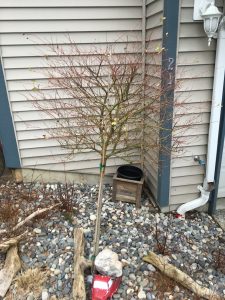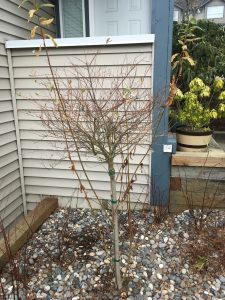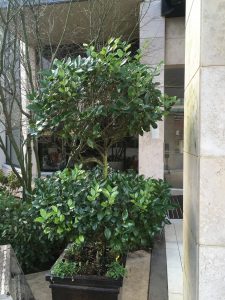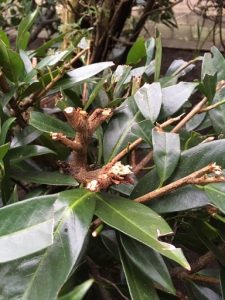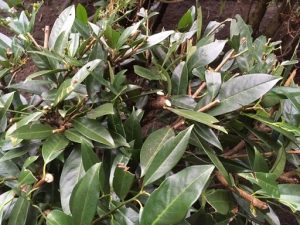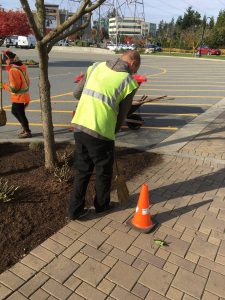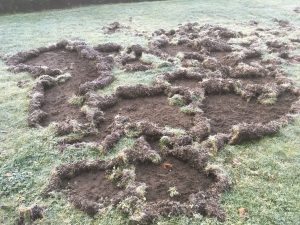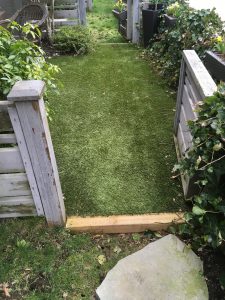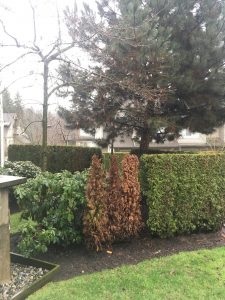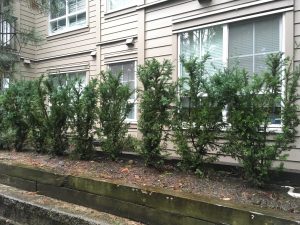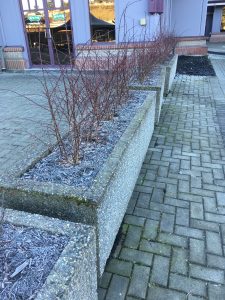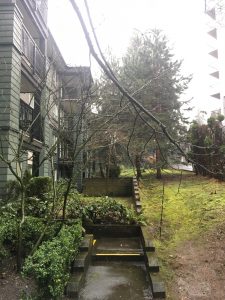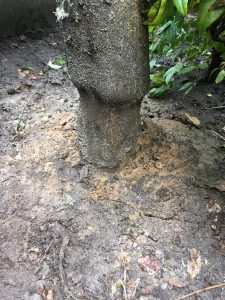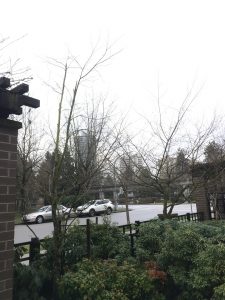“Bonsai” response is a term I learned from my mentor Dr. Linda Chalker-Scott. It happens when plants are under stress. In this blog post the stressor is lack of water but it could be something else.
The plant sends out new shoots from the base, trying to bonsai itself in response to the stress. I learned this while going through Dr. Linda Chalker-Scott‘s new Great Courses course “The Science of Gardening“. You can read my blog post review of the course. All I will say here is that it’s highly recommended, if you can get it on sale. The regular price is brutal so forget it, unless you have deep pockets.
Site example
As soon as finished the course, I ran into a perfect example from one of my work sites. I normally float around amongst our work crews, helping and training. But, in 2018, we needed someone to take care of a small site so I did it once a week.
In spring we installed new beds on opposite corners. We planted Berberis thunbergii, Sedums, Pennisetums, Carex, Spireas and Japanese willows (Salix integra); and everything got mulched with river rock.
All of the plants developed nicely and the river rock kept weeds in check. But then summer hit and the differences were clearly visible. On the left corner lives a home gardener who waters regularly. On the right corner lives a busy family. Both have garden hoses close by. Let’s talk about the right side.
The tips of the Japanese willow shoots were turning brown so I watered the bed every week. My boss doesn’t normally like to do this but, hey, he wasn’t there and I have research to do for my blog posts.
Then I started noticing new shoots developing lower on the main stem. This was clearly the plant’s bonsai response to water stress. The left bed specimen didn’t do this because the home gardener watered regularly
I didn’t prune off the bonsai shoots until winter 2019. We will see what happens in spring.
I always buy my work boots from Stihl because I love my Lawngrips. They’re designed for landscape professionals: they look great, they have anti-slip soles for lawn surfaces and they cost just over C$100. I normally buy at least two pairs every season. You can read my review of the boots from April 2017.
The unthinkable
This past January I did the unthinkable: I bought a different pair of boots. I walked into my neighborhood work wear and safety store to see if they had any sweatshirts on sale and then it hit me. I was wearing the cheapest Wal-Mart rubber boots because my Stihl boots had lots of cracks. That’s not good.
As landscape supervisor I have to set a good example and look good for our crews and clients. My cheap rubber boots didn’t have steel-toes and cracks in my boots were unacceptable.
Then I saw JB Goodhue Guardian 14202 boots on sale for C$69. What a steal. I tried them on and bought them because they fit my winter budget and they were right there, ready to come home with me.
The Lawngrips are harder to buy because they’re only available from Stihl dealers and I have to travel much farther to get there. Assuming, of course, they have my size. But, if you love the boots like I do, you will overlook this.
In January I was a busy soccer Dad budgeting for an international soccer tournament in Las Vegas. If I had to cheat on my favourite work boots to save some cash then so be it. I did feel strange walking away with different boots.
Review
The biggest surprise is how soft my heel strikes are. I’ve had work boots before that were super stiff but not these. When I walk, the heel strike is soft. I really like it.
The look is fairly plain; I miss my Stihl logo on the side.
I did experience some discomfort above my right ankle for about three days. It scared me because sometimes suspicious boots go on sale. But, as it turns out, I just had to break them in and now, weeks later, they feel fine. Actually, I had no choice but to break them in because of my budget and because I’m a dedicated landscape blogger.
Specs
You can see the specifications for my Guardian 14202 boots on the company’s website.
Conclusion
If money is no object and you are a professional landscaper then buy the Stihl Lawngrips. If you enjoy saving money, JB Goodhue’s industrial Guardian 14202 boots are a great choice, especially in winter. The boots kept me nice a cozy last week in freezing morning temperatures.
Note that my Guardian 14202 boots were on sale for C$69. The regular retail price is C$114.99. At that price I would go for the Stihl Lawngrips every time.
I love hand-pruning! It’s quiet and usually it leads to soft-looking shapes unlike harsh and noisy power shearing. It also allows you to feel the foliage and think about other issues as you work. Below I discuss two winter hand pruning examples.
Privet shape
I was beaming inside and out when I was asked to hand prune potted privets (Ligustrum japonicum) by two residential tower entrances. All of a sudden, a routine maintenance day turned into joy!
I pulled out my Felco 2 hand pruners and went to work. Incidentally, always try to use good tools for pruning. Cheap hand pruners could produce cheap looking shrubs.
My job was to snip out the light green new growth and still leave the privets natural looking. It’s hard to achieve this with power shears which shred the foliage and make the plant look too tight. A more natural form is preferable in this case.
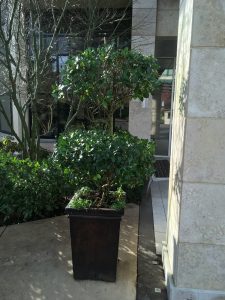
All done and still natural looking. This kind of work is like therapy.
Laurel fix
Another easy hand pruning job involves fixing laurels (Prunus laurocerasus ‘Otto Luyken’) after power shearing. Because power shears can only work at one level there is always some shredding visible afterwards. Fixing this is another beautiful hand pruning job.
Find the worst shredded parts and hand snip them out so the wood blends in more. Always try to cut just above a leaf node so the leaves cover up the cuts. The laurel will look better than it did post power shearing.
Conclusion
Hand pruning can be relaxing and almost feel like therapy. I love the quiet snipping and the resulting soft shapes. Power shearing tends to be harsh and noisy. When you shred laurels with your power shears, take the time to snip out the ugliest looking stems.
I’m not kidding, landscapers with brooms is a real thing. I’ve seen commercial landscapers in White Rock using brooms for clean-up. You don’t see that much except for the West End of Vancouver where blowers are officially banned. I worked there way before the ban and I have no idea how it affects landscape maintenance.
White Rock
Take a moment to examine the picture below and note every detail. Then continue reading below. (I didn’t ask for permission to shoot the photo so you can’t see the workers’ faces. The girl is cute!)
Don’t dismiss these dudes too quickly. In this commercial landscape setting brooms actually make a lot of sense. The only potential downside -other than the workers flying off- could be slower completion times when compared to backpack blowers; but I’m not completely convinced. See note 8 below. There are many positives:
- The many shopping mall islands are small and easily cleaned-up by two brooms.
- The workers don’t require ear protection and their exposure to dust is minimal.
- There is no blower to lock up from would-be thieves. Nobody steals brooms.
- There is zero noise pollution generated and the nearby health clinic patients must appreciate that.
- There is zero chance that parked cars will get covered in dust. The nearby golf store patrons are well-healed and sensitive.
- Brooms don’t require expensive fuel and don’t produce harmful particulates. They’re also cheap and don’t cause fuel spills.
- Brooms allow the workers to hear traffic. Note that they are correctly wearing high-visibility vests and using safety cones. Working in pairs is safer and more efficient. It also makes the work day more fun.
- Blowing small islands like this is awkward even on low power because there is always the risk of splashing soil.
- Using brooms gets both workers moving.
City work
I spent my 2014 season working under a municipal gardener and she absolutely detested noisy backpack blowers. I think we used them less than ten times during the season. And we survived because gardening doesn’t create as much mess as landscaping. I must confess that it was a nice change from regular landscaping. I didn’t miss the noise.
So there you have it, it’s possible to maintain landscapes without backpack blowers.
Why do people install costly plastic lawns? This is a good question. And so is this one from a person on Quora.com, “Why would daycares install plastic turf?” Let’s take a look.
Easy maintenance
It’s easy to maintain plastic lawns. I imagine you just gently sweep them or hose them down. People are busy and maintaining natural grass is expensive. You need machines, time, gasoline or electricity, you have to deal with green waste and fertilizer purchases and it all requires effort. Probably weekly effort.
That’s why some people hire professionals like Proper Landscaping to keep their lawns beautiful; and some give up by making a costly plastic turf purchase.
Situations calling for plastic lawns
Chafer beetles
On the West Coast, our lawns are plagued by European chafer beetles. The larvae are in the lawns and animals come dig them up thereby destroying patches of lawn. Now, the cheapest fix for this is raking, top-dressing with soil and over-seeding. But it gets very old when you have to do this annually. All of a sudden, plastic turf starts to look attractive.
Patios below grade
I’ve seen shady, below grade patio lawn patches that turned to nothing every winter. It was a constant fight to keep five narrow strips of lawn alive. So, the owners all opted for plastic turf because it eliminated the headaches with maintenance.
Dog damage
The first time I ran into a company installing plastic lawn was in White Rock. By the way, if you’re still considering plastic lawn after reading this blog post, then I can put you in contact with this installer. Now, back to White Rock.
The owners have a narrow lawn patch and a large dog. They also like to use their sunny patio. But the small patch of lawn was no match for their dog. The copious amounts of dog urine “burn” the lawn because it’s way too much fertilizer for the lawn to absorb.
You can spray the dog spots with water in theory but in practice people just kick the dog out and let it do its business.
So, in this case, plastic solved their problem.
Poor access
One case from England showed an enclosed backyard where the only mower access was through the house! That’s not a good situation. I guess you could use a line-trimmer but you would still have to go through the house and the result would be a nice looking lawn. Here plastic lawn made sense.
The case against plastic lawns
I don’t like anything artificial in nature. If I had a house, I would either go for some sort of green alternative or I would maintain the lawn without gasoline mowers. If I had to use a gas-powered mower, I would definitely use Aspen fuel instead of regular gasoline.
I would never let my kids attend kindergarten with plastic turf.
Why not plastic turf? This is the key question.
Heat
Plastic lawns heat up and may require summer watering. And summer watering may not be possible with summer watering restrictions. A few years ago my son played a soccer match in sunny White Rock and the plastic turf was so hot, his plastic cleats were super hot. And I don’t even mention the off-gassing that may be going on as the heat hits the plastic. Right now, heat absorption is the biggest problem with plastic lawns.
Science notes
Maria Ignatieva, writing in Science (October 12, 2018, vol. 362, issue 6411) states that, “…..substituting …with plastic lawns eliminates real nature from cities and arguably reduces overall sustainability given that they reduce habitats, decrease soil organisms, pollute runoff water, and may have yet unknown negative consequences for human health through plastic particles.”
When I mentioned the above quote in my answer to the Quora question, some people got mad. I’m not saying you can’t have your plastic lawn. If you have deep pockets, do it. It’s your lawn.
But, plastic lawns kill or severely diminish life in the soil because they limit water infiltration and cook the soil as they heat up. Also, not many organisms want to make plastic turf their home.
Conclusion
I totally agree with Ignatieva, plastic lawns are not the answer. Overall, plastic lawns heat up our cities and they remove real nature from them. I personally would never buy one.
But, there are some desperate cases where plastic eliminates maintenance headaches.
Newly planted cedar (Thuja occidentalis) hedges often fail to establish in our strata landscapes. I see it all the time and it feels like a waste of time and money. While there may be soil issues, I find that most of the time it’s lack of proper watering that affects the new hedges.
New cedar hedges require lots of water but residents are busy with their lives; and landscapers aren’t really paid to water the landscape. They have other pressing issues to attend to.
I personally planted the three brown cedars (Thuja occidentalis ‘Smaragd‘) pictured above and I watered them in. That’s it. Then it’s up to the resident near-by to water them regularly; and she happens to be a home-gardener.
Now, there is some shading from a dogwood and a shore pine but for hedges this new it’s definitely lack of water.
Now what?
So now what? More cedar hedges? I doubt it. That would be just throwing money away.
Let’s take a look at alternatives.
Yews
Finally, some good news. I planted this row of Hick’s yews (Taxus) in a shady back area facing a public park. There used to be cedars but they were all doing badly; some weren’t even upright. So we tossed them all and started over.
I planted these yews last year and they inspired this blog post because it was nice to see them all green and growing. That’s how I like it. I’m confident they will do well. Yews are more resilient than cedars.
The yews will fill out and may require gentle hand pruning on top.
Berberis
This was another fight. Narrow planter boxes planted with cedars and the plants kept failing. The planters offer limited soil and root areas and the building maintenance personnel are too busy to water regularly. In addition, the patio heats up in summer, blasting the cedars with reflected heat.
So we installed Berberis thunbergii which are tougher than cedars. They have beautiful purple foliage and in winter they sport red berries. I will check on them in twelve months.
Conclusion
Cedar hedges require lots of water to establish in the landscape but, sadly, they don’t often receive adequate amounts. Then they decline and die which is a waste of money and time. Luckily, there are alternatives like yews and Berberis. You can try other plants and have some fun with it.
Proper landscape maintenance requires good planning. Depending on the size of your site, there should be a clear rotation so that every corner of your property gets serviced.
Jumping helter-skelter through your sites could lead to disaster. And yet, as much as you try to stick to your plan, requests and emergencies can side track you.
Requests
Small owner requests should be done right away, unless strata approval is required. For example, you can’t remove a small landscape tree just because Mrs. Rose from unit 6 wants it gone. But, if she has a few big weeds by her entrance, take care of it right away.
Bigger requests should be noted and pushed to your next visit. Try not to stray from your plan for this week but do write it down so you don’t forget.
This happened to me recently at a new site. The owner had asked me to re-stake his Styrax japonicus tree but I didn’t have a staking kit. So I promised him I would take care of it next week but I failed to write it down. Then I was slightly red-faced when he asked me about it the following week. Always write down requests that can’t be done on the same day.
The tree is now re-staked.
Emergency obstructions
Some tasks are more urgent. Like the exit walkway pictured below. As soon as I saw it, I knew it had to get done today. It’s just too annoying for people accessing the building.
The big branch belongs to a mature Pin Oak (Quercus palustris) and it’s leaning on a vine maple (Acer circinatum). Since I didn’t have an extendable chainsaw, I pulled down the big branch and used a hand saw. It’s not pretty but at least the residents will not suffer any injuries.
Take care of walkway obstructions right away.
I was recently sent to a new strata site to re-stake a Japanese snowbell (Styrax japonicus) tree. The owner was concerned because the tree was leaning on his gate. So I picked up the required tools and materials for tree staking: stake pounder and a headset, two stakes, arbor tie, and a staple gun.
A sad specimen
Compared to its cousins in neighbouring yards, this tree wasn’t doing as well. And I wonder why? It has fewer branches thanks to past pruning, and there is a distinct bump on the trunk close to the ground which almost looks like the result of previous injury or girdling.
First, I removed the old stakes. Tree stakes shouldn’t stay on for more than a year and clearly this tree is older than one year. Then I installed two new stakes so the tree wasn’t leaning anymore. When I moved the tree trunk, the root ball moved as well.
This is where the unscientific “wiggle test” comes in. I learned about this test from Dr. Linda Chalker-Scott. When you gently move a tree trunk the root ball shouldn’t be moving on healthy, well-established trees. The same is true of shrubs.
On this Styrax there was a lot of movement so I jumped over the fence into a neighbouring yard and performed the same test on another Styrax. The trunk moved but the root ball held nicely suggesting that the tree is well-established and healthy.
I used a staple gun to attach the arbor tie to both stakes and I had just enough staples for the job. Always bring spare staples and extra stakes just in case things go wrong.
Future
I worry about this tree because it should be well established like its cousins nearby; I’m assuming, of course, that all of the trees were planted at the same time. When I performed the “wiggle test“, the root ball was moving which is bad. Considering the size and age of this Styrax, it should be nicely established. But, since I’m new on this site, I have no idea what happened in this yard in previous seasons.
If you have doubts about trees and shrubs in your gardens, try the “wiggle test“. It’s unscientific, but it gives you a good indication about the health of your plant.


